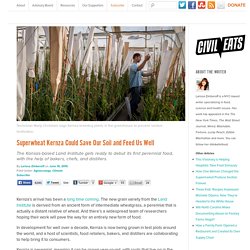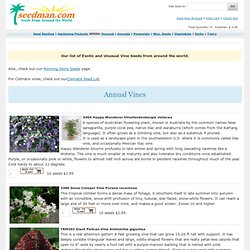

Superwheat Kernza Could Save Our Soil and Feed Us Well. Kernza’s arrival has been a long time coming.

The new grain variety from the Land Institute is derived from an ancient form of intermediate wheatgrass, a perennial that is actually a distant relative of wheat. And there’s a widespread team of researchers hoping their work will pave the way for an entirely new form of food. In development for well over a decade, Kernza is now being grown in test plots around the world, and a host of scientists, food retailers, bakers, and distillers are collaborating to help bring it to consumers. Kernza is perennial, meaning it can be grown year-round, with roots that live on in the ground through winter.
Corn, wheat, and most of the other grains we eat, on the other hand, are annual crops, which must be replanted anew every year, and require seeds, fertilizers, and pesticides for each planting. That’s not all. Annual wheat growing on the left, Kernza growing on the right Grassy, with a Hint of Magnesium Beyond bread, Kernza is also appearing in whiskey. Shining a Light on Blight... - OIKOS Tree Crops. EPA: Those Bee-Killing Pesticides? They're Actually Pretty Useless. Was it all for nought?

Note: bumblebees, pictured here, have also been shown to be harmed by neonics. KZWW/Shutterstock So, there's this widely used class of pesticides known as neonicotinoids, marketed by chemical giants Bayer and Syngenta, that have emerged as a prime suspect in honeybee collapse, and may also be harming birds and water-borne critters. Gardening Articles. Gardeners who visit my backyard garden-orchard in Thousand Oaks, California, usually ask why I have so many jujube trees.

My answer is easy: No other tree gives me so much pleasure for so little effort. The jujube (pronounced juh-ju-bee or juh-juh-bee) is a member of the buckthorn family, or Rhamnaceae. Its botanical name is Ziziphus jujuba, and its common names is Chinese jujube, or sometimes, just jujube. Though the plant's origin is probably Syria, it was distributed throughout much of the Mediterranean region at least 3,000 years ago and today is most widely grown in China.
This deciduous tree grows 12 to 15 feet tall, although trees are known to reach 30 feet. Fruits ripen in late summer to early fall. Masanobu Fukuoka interview - On Seedballs. New Fruits for Arid Climates. Index | Search | Home | Table of Contents Mizrahi, Y., A. Nerd, and Y. Sitrit. 2002. Bill Mollison - Global Gardener 4 - Urban. Jerusalem artichoke. The Jerusalem artichoke (Helianthus tuberosus), also called sunroot, sunchoke, earth apple or topinambour, is a species of sunflower native to eastern North America, and found from eastern Canada and Maine west to North Dakota, and south to northern Florida and Texas.[1] It is also cultivated widely across the temperate zone for its tuber, which is used as a root vegetable.[2] Description[edit] It is a herbaceous perennial plant growing to 1.5–3 m (4 ft 11 in–9 ft 10 in) tall with opposite leaves on the upper part of the stem but alternate below.[3] The leaves have a rough, hairy texture and the larger leaves on the lower stem are broad ovoid-acute and can be up to 30 cm (12 in) long, and the higher leaves smaller and narrower.

The flowers are yellow and produced in capitate flowerheads, which are 5–10 cm (2.0–3.9 in) in diameter, with 10–20 ray florets. Raw Rob: Raw food, wild food & consciousness. I’m slowly beginning to feel some level of confidence in being able to find a good variety of wild food.

I’m eating plant leaves and flowers, tree leaves and blossoms, berries and small insects. I’ve recently started eating ants and have finally lost that squeamishness I used to get when eating insects. I’m sure I’d still get it with larger insects, but with the small ones I’m feeling like it’s a very natural thing to do. Lime leaves (as in Tilia x europaea, not the citrus fruit) are very tender at the moment and have a very mild taste. The Basics of Natural Farming (part 1 of 2) Feral Scholar » Blog Archive » Humanure Composting.
Solving All the World's Problems - in a Garden. Composting-toilet-diagram.gif (400×455) Methane Digesters for Fuel Gas and Fertilizer - ToC. Natural Farming / Forest Gardening « SHIKIGAMI. The end of November is fast approaching and I have a post that I began back in September still in front of me.

Sorry to those who have been following the ‘monthly’ report on the wild foods we are foraging. Better late than never, right? Unfortunately, attempting to document our wild diet has come at the expense of writing about anything else. And even then I am barely scratching the surface of our foraging adventures or doing justice to the particular plants of which there is so much more to say. So, following this post I think it will be time for a change in approach.
September saw us looking skyward. Kuri (Castanea crenata), a native of the Japanese forests, in its true wild form is known as yamaguri or mountain chestnut. Www.cookscommunitygarden.org/docs/Resources and Guides/Permaculture/forest gardens.pdf. No-till mulching gardening and wild gardening Fukuoka and Ruth Stout. Common and Exotic Fruit and Nut Trees. Unusual and Exotic Vine Seeds From Around the World. Our list of Exotic and Unusual Vine Seeds from around the world.

ROOT DEVELOPMENT OF VEGETABLE CROPS. JOHN E.

WEAVERProfessor of Plant Ecology, University of Nebraska WILLIAM E. BRUNERInstructor in Botany, University of Nebraska. Root Development of Field Crops: Table of Contents. JOHN E.

WEAVERProfessor of Plant Ecology, University of Nebraska McGRAW-HILL BOOK COMPANY, INC. NEW YORK: 370 SEVENTH AVENUE LONDON: 6 & 8 BOUVERIE ST., E. Database Search. To the best of our knowledge all the information contained herein is accurate and true.

However we cannot guarantee that everyone will react positively to all edible plants or other plant uses. It is commonly known that many people suffer allergic reactions to conventional foods and products. Even amongst the more commonly eaten fruits, for example, there are plenty of instances where people react badly to them: Many people are allergic to strawberries and will come out in a rash if they eat them.Some people develop a rash if they touch the stems of parsnips. Potatoes become poisonous if they turn green.Eating large quantities of cabbage can adversely affect the thyroid gland.
Tim Gamble: How To Make a Forest Garden, part three. This is the third part of a three part essay on how to get started in forest gardening (read part one and part two). For those unfamiliar with the concept, I would suggest reading my Introduction to Forest Gardening. Check out these organizations and websites for more information on forest gardening, including ideas for what trees, shrubs and other plants may be suitable for your forest garden. Agroforestry Research Trust - The world's leading temperate forest garden research institution. Excellent publications, including Agroforestry News.
Creating a Forest Garden: Working with nature to grow edible crops: Amazon.co.uk: Martin Crawford. Review Martin Crawford has spent 15 years creating what is almost certainly the best forest garden in the temperate world...and the breadth of his knowledge matches the depth of his experience. I've been looking forward to this book ever since I've known he was writing it. --Patrick Whitefield, author, Permaculture in a Nutshell and The Earth Care Manual. Even if you weren't going to try forest gardening, I challenge you not to want to by the end of this book. Publications data & online order form. Publications You can use this form to order publications online (see ordering information for other ways to order) We can send publications anywhere in the world.
Books and other publications are written by Martin Crawford and published by the A.R.T. unless noted otherwise. Garden Plan - Landed - forest gardening. Penpol Report. Survey and Research Project on 'The Field' A report is available of the survey and research project carried out in 2009-10 on the 'The Field', the experimental site of Ken and Addy Fern ( Plants For A Future founders) in Cornwall, where they carried out research and provided information on edible and otherwise useful plants suitable for growing outdoors in a temperate climate. Over time they planted 1500 species of edible plants on 'The Field' in Cornwall, which was their base since 1989.
The Report was written by Dr Carol Wellwood, who also acted as Project Manager of the Survey and Research Project. The Report is now only available on CD here. Horticulture - The Art & Science of Smart Gardening. From the March 2010 issue of Horticulture. Cut and come again salads. Horttech.ashspublications.org/content/1/1/54.full.pdf. Activities.byui.edu/married/pdf/Companion Planting Guide.pdf. RESULTS OF SHADE VEGETABLE PLANT. Dense planting « A Life in the Country. A Life in the Country ~ The Growing Disaster of Impoverishment! Www.permaculture.org.uk/sites/default/files/page/document/MixedVegGarden_A4_colourbooklet.pdf.
Plant Spacing and Water Requirement. I'm sure if you've read much permaculture literature has come across the idea that dense planting translates to less water requirements. The reasoning goes that it's because dense plantings shade the soil more, which leads to less evaporation from the sun. It's certainly true that shading the soil leads to less water loss, there's a pretty dramatic difference between how fast a garden bed of exposed soil dries out compared to a mulched one. Our experience with Permaculture. Here is my presentation from the Sustainability Festival on the 20th ..... Why? - Shady Grove Natural Farm. Why Edible Landscaping? Although there are over 20,000 species of edible plants in the world, fewer than 20 species now provide 90% of our food. It's ironic that as cheap energy in the last century made access to a greater diversity of foods easy and inexpensive, the diversity of foods that make up the bulk of our diets actually decreased.
Our palate has withered, so to speak, as a culture. 2012 Plant List - Shady Grove Natural Farm. Actinidia kolomikta, Arctic Beauty. Don't Kill Those Weeds!!! (Editor's Note: This article was originally published on August 27, 2008.) Some weeds actually benefit the soil thus improving our gardening efforts, and weeds can tell us a lot about the condition of our soil. I began learning about weeds only recently thanks to some threads on Dave’s Garden, although I still have volumes to learn. Intensive Gardening Methods. Self Fertile Apples (woodland forum at permies) We all know that most apples are not self-fertile, and often need another apple tree nearby in order to produce fruit. Often, the other tree must be a different variety. Stone fruits. Oregon. Buy Mail Order Plants, Seeds, & Bulbs - PlantScout - Dave's Garden. All about unusual fruit to pick - serviceberries, saskatoons, gooseberries, olliaberries, boysenberries, loganberries, tayberries and more.
2012 Plant Sale. Grow tomatoes without irrigation or fertilizer (plants forum at permies) Celia Ashman. Www.permaculture.org.uk/sites/default/files/association_work/2012/june/mixed_veg_results-web.pdf. Lambsquarter and deciding on which weeds to keep. Dynamic Accummulator Weeds. Weeds to combat weeds??? (plants forum at permies) To weed or not to weed, what would be Sepp's answer? The Wild Garden: Hansen's Northwest Native Plant Database. Oregon Tree Fruits and Nuts. Plants That Attract Beneficial Insects. Resources / Resources browse. Edible Landscaping with Charlie Nardozzi. Attract Beneficial Insects with Flower Borders. Organic Pest Control: The Best Plants to Attract Beneficial Insects. Www.cog.ca/documents/WeedsMessengerSU06.pdf. Untitled Document. Wp-content/uploads/2009/04/plant-catalog-p3.pdf. Index of /wp-content/uploads/2009/04.
Wp-content/uploads/2012/03/Guilds.pdf. Wp-content/uploads/2009/04/Plant Catalog p1.pdf. America, Found and Lost - National Geographic - May 2007. Glomalin. Dynamic accumulator. Host271.hostmonster.com/~paulgunt//htf/sites/default/files/2012 Herb Primer - web.pdf. Water Harvesting in the Negev. Farm Bill "10 Base-Acre Rule" Implementation. Edible Forest Garden Wiki - Useful Plant Species - Regenerative Agriculture - Edible Landscaping. Sepp Holzer's Permaculture: A Practical Guide to Small-Scale, Integrative Farming and Gardening - Free eBook!
Farming for Profit & Quality of Life. Viva La Veggie; a local food revolution. SEED-SOIL CONTACT AND THE ROLE OF VAPOR IN GERMINATION. Dynamic Accumulators for Temperate Climates. Tap Rooted Plants (plants forum at permies) An Urban Landscaper's Guide to Replicating Nature's Complex Networking Systems: Search results for dawson. Bill Mollison - Global Gardener 4 - Urban. 25 Plants You Should Consider Growing – Casaubon's Book. Celosia: Nature’s Prettiest Vegetable. Practical Plants. Millennium Ark: Stocking the Root Cellar. Rocket stove mass heater. Beneficial Insects Fact Sheet. Tansy. Wild parsnip: It's like raiding a garden, but better by Samuel Thayer from the May/June, 2007 issue of Countryside & Small Stock Journal.
Backyard Edibles: The Food Under My Feet. Journey to Forever. Www.perennialsolutions.org/all-nitrogen-fixers-are-not-created-equal. List of companion plants. PAHS - Umbrella House. Prairie-root-line-drawing.jpg (1334×865) Roots, tubers, plantains and bananas in human nutrition - Nutritive value, Methods of cooking and processing.